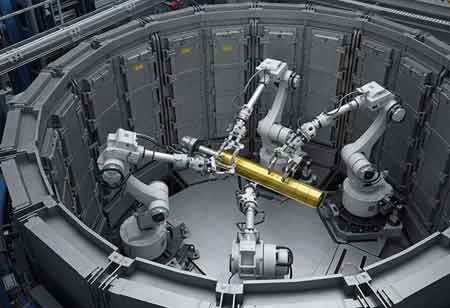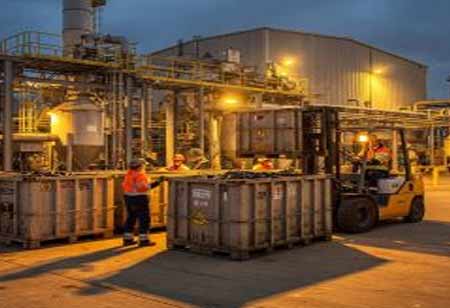CLOSE
Specials
I agree We use cookies on this website to enhance your user experience. By clicking any link on this page you are giving your consent for us to set cookies. More info
Be first to read the latest tech news, Industry Leader's Insights, and CIO interviews of medium and large enterprises exclusively from Energy Tech Review
Thank you for Subscribing
The Lifecycle Imperative in Long-Duration Energy Storage
Long-Duration Energy Storage (LDES) is essential for a decarbonized economy, requiring a shift to Circular Storage, integrating sustainability into design, and enhancing recycling for a sustainable future.

By
Energy Tech Review | Tuesday, September 09, 2025
Stay ahead of the industry with exclusive feature stories on the top companies, expert insights and the latest news delivered straight to your inbox. Subscribe today.
Long-Duration Energy Storage (LDES) represents the foundational technology indispensable for achieving a decarbonized global economy. It facilitates reliable renewable energy by mitigating the intermittency inherent in solar and wind power. As these technologies proliferate worldwide, ensuring their efficacy in addressing energy challenges without generating new environmental liabilities necessitates a transition from a linear to a circular operational model. Circular Storage emerges as the subsequent advancement, an approach wherein sustainability and end-of-life recovery are not secondary considerations but integral elements embedded within the initial design phase of LDES systems. This comprehensive perspective redefines value, extending its scope beyond mere kilowatt-hours to encompass the complete lifecycle of all constituent materials and components.
Lifecycle Design: The Blueprint for Circularity
The foundation of a circular storage system is established long before manufacturing begins, through Lifecycle Design—a proactive approach that embeds sustainability into every stage of a product’s existence, from raw material extraction to decommissioning and recovery. Central to this methodology are modularity and standardization, which enable LDES systems to be built with interchangeable components that extend longevity and adaptability. Instead of discarding entire units, faulty parts can be swapped, and as technology evolves, upgrades can be integrated through plug-and-play modules rather than full replacement. This design philosophy not only extends operational life but also maximizes resource efficiency and lowers the total cost of ownership across the system’s lifespan.
Material selection is another critical pillar of lifecycle design. A circular approach prioritizes the use of materials that are abundant, ethically sourced, non-toxic, and inherently recyclable. This involves a conscious move away from reliance on rare-earth elements or materials with complex, energy-intensive recycling processes. The focus shifts to earth-abundant materials and chemistries that can be easily recovered and reprocessed with minimal degradation in quality. This not only mitigates environmental harm but also de-risks supply chains, insulating them from the geopolitical volatility and price fluctuations associated with scarce resources.
Central to this design philosophy is Design for Disassembly (DfD). Unlike conventional manufacturing, which often relies on permanent adhesives, welds, and integrated components that are nearly impossible to separate, DfD employs techniques like mechanical fasteners and clearly layered assemblies. This ensures that at the end of the system's life, it can be efficiently and safely deconstructed. Components can be sorted for reuse, remanufacturing, or material recovery, transforming a potential waste stream into a valuable resource reservoir.
Recyclability and Material Recovery: Closing the Loop
While lifecycle design sets the stage, the true test of a circular system lies in its ability to effectively close the material loop at the end of its service life. This requires a robust infrastructure and advanced technologies for recycling and material recovery. The goal is to move beyond rudimentary downcycling, where materials lose their value and are repurposed for lower-grade applications, towards a system of high-fidelity recovery.
Achieving this demands sophisticated sorting and processing technologies. Automated systems utilizing sensors, machine vision, and artificial intelligence can identify and separate different materials with a high degree of precision. This is crucial for purifying material streams—for example, separating different metals, plastics, and electrolyte components—to a grade where they can be reintroduced into the manufacturing of new high-performance products, including the next generation of LDES systems.
The ultimate aim is upcycling, where recovered materials are processed in a way that preserves or even enhances their quality. This high-value recovery is the economic engine of the circular model. When the materials retrieved from a decommissioned storage asset retain a significant portion of their original value, the economic case for recovery becomes compelling. This transforms the end-of-life phase from a cost center associated with disposal to a revenue-generating opportunity. To make this vision a reality, the industry must foster the development of robust secondary material markets. A predictable supply of high-quality, recycled materials creates a reliable alternative to virgin resources, providing manufacturers with cost-effective and sustainable inputs.
Integrating ESG: The New Metric of Success
The transition to a circular storage economy represents not only an engineering challenge but also a redefinition of success, with ESG reporting emerging as the key framework for evaluating the sustainability and long-term viability of LDES projects. Investors, regulators, and consumers are increasingly looking beyond simple financial returns to evaluate a technology's broader impact.
Within this framework, circularity is a powerful differentiator. Transparency and traceability across the supply chain become paramount. Technologies like blockchain are being explored to create immutable records that track materials from their point of origin, through the manufacturing process, during their operational life, and into the recycling and recovery phase. This provides verifiable proof of sustainable sourcing, ethical labor practices, and the percentage of recycled content, substantiating ESG claims with hard data.
Ultimately, circular principles are intrinsically linked to robust financial performance and risk mitigation. By reducing reliance on virgin materials, companies fortify themselves against supply chain disruptions and price volatility. Designing for longevity and repair reduces operational and maintenance expenditures. A demonstrable commitment to sustainability and end-of-life stewardship enhances brand reputation and social license to operate. For investors, LDES systems designed for circularity represent a de-risked asset with a more resilient and predictable long-term value proposition. In this new landscape, a system's carbon footprint, its recyclability rate, and its contribution to a just and sustainable economy are as critical to its success as its efficiency and capacity. The industry's ability to embrace this holistic, circular vision will determine its legacy and its ultimate contribution to a truly sustainable energy future.

Copyright © 2025 Energy Tech Review. All rights reserved






